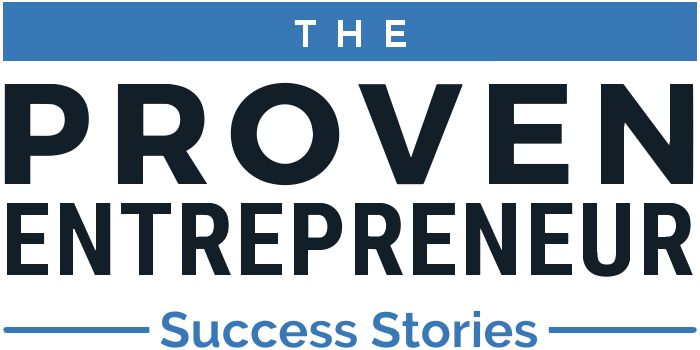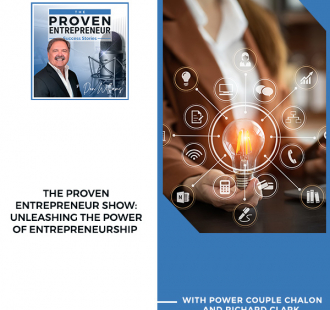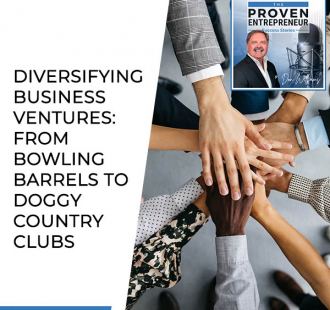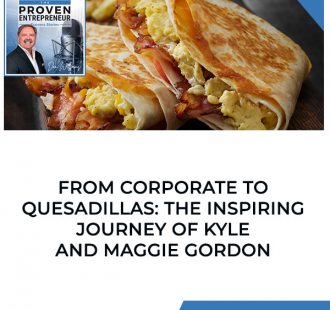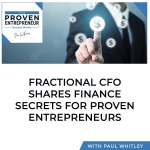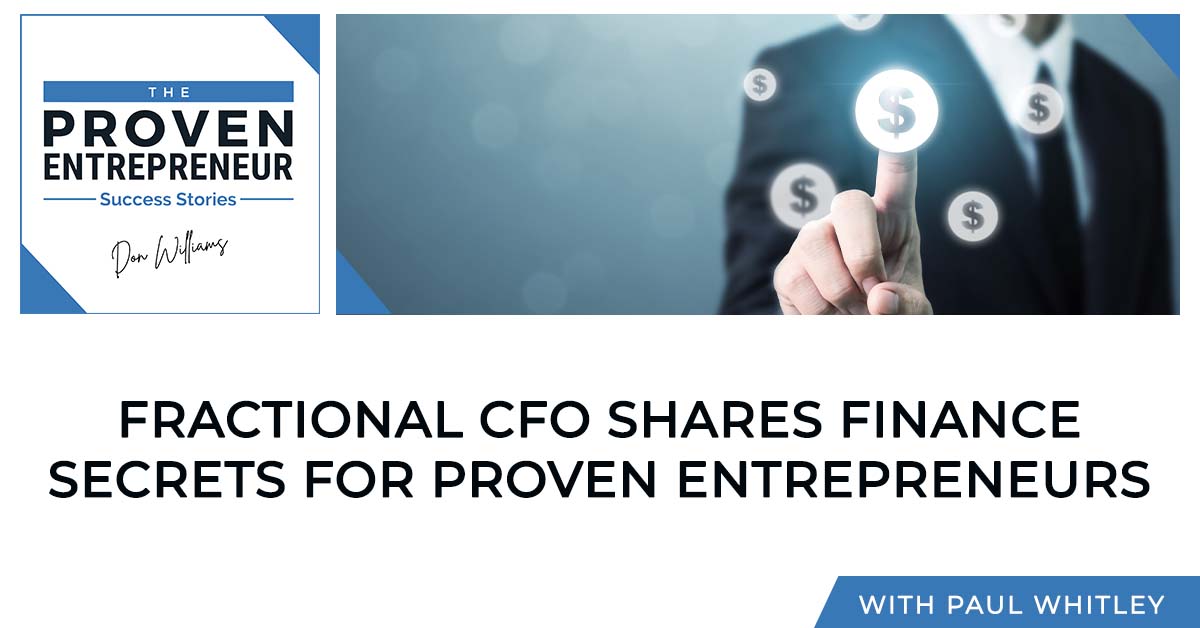
There are finance secrets that proven entrepreneurs need to know to keep growing. Don Williams warmly welcomes his friend Paul Whitley, the Fractional CFO of C-Suite Support. Paul shares how business people need to consider joining the Entrepreneur Organization, a great organization for small companies. It’s where company owners who maybe had never had any “help” from the federal government received millions of dollars of help. Paul goes on to share numerous nuggets of finance wisdom for hungry listeners. Dive in!
—
Listen to the podcast here
Paul Whitley – Fractional CFO Shares Finance Secrets For Proven Entrepreneurs
My guest is a good friend of mine who lives on the other side of the metroplex, Paul Whitley, with C-Suite Support. Welcome, Paul.
I’m glad to be here. I thought you were going to say the other side of the world since Fort Worth doesn’t consider Dallas to be in the same geographic area.
I’m showing my best manner. I’m not from here, so I don’t get all that. Let’s jump right in. Where are you from? Where were you born and raised?
I was born in Dallas, Texas, traveled the country in my career and then came back to Dallas.
Let’s go way back to little Paul. Were your parents entrepreneurial?
Not at all.
What did they do?
My mother ran an insurance route, debit route if you’re old enough to remember those kinds of things. My father worked for a grocery store. We had a foster home for kids out of Buckner’s offering. It was unique.
On the debit route, it’s a little entrepreneurial, even though maybe not technically a business but responsible for everything.
Retool, regroup, and find another way to go when you fail. Click To TweetShe also did a personal income tax, so that would be entrepreneurial. That’s what got me into all the accounting. I ended up helping her do income tax when I was a kid. Here’s a ten-year-old doing somebody’s personal income tax. That’s scary.
It’s so common that an entrepreneur, if you look at what they do, they can trace that back somewhere to their childhood. Tell us about your first job where you got a paycheck.
You have to define the paycheck but at ten years old, I started working in the store that my father was running at that time for $0.50 a night. I’d go to work from school until 10:00 and go home with him every other night and work on the weekends. I did that until I got my first real job with an actual paycheck at fourteen.
What was that job?
At A&P Grocery, I was a package boy.
Does that mean you put groceries in the bag and carry them to the car?
How will you translate that? Yes.
I was having a conversation with someone where I was like, “I don’t think they do that anymore.”
They do. I’m going to go throw a bone here to Kroger and Tom Thumb. They both do that but with special needs kids, which is wonderful. At least the ones around me are in Plano and I live in Plano. That’s close to Dallas. Nobody knows where Plano is.

Tell us about your company.
Years ago, I was a Hedge Fund Director. That was in 2008 and that hedge fund failed. When it did, I had a Millennial recruiter ask me if I needed a walker when I was applying for an actual real job. I said, “I better retool, regroup and find another way to go.” I did and started working with clients that I had at the hedge fund, helping them get funded with other hedge funds. Ultimately, I got them to the point where I’ve got all the risk mitigants out of the way. We pay them and the banks reduce their cost. We did that for a long time.
Years ago, there was a little guy by the name of Peter Bolin. I had breakfast and coffee with him. I was starting a networking group, which you’re somewhat familiar with, the C-Suite Support. Someone introduced me to him. I looked him up on LinkedIn, CFO of ten companies. I’m thinking, “This guy has trouble holding a job because he’s not that old.” I met with him anyway. We’re having a conversation. I asked him, “What is it that you can’t keep a job?” He starts laughing and says, “No, I’m a CFO for ten companies.” I said, “How do you do that?” That was the embryo and the change. That’s what started what I do as a fractional CFO for multi companies.
Tell us exactly what fractional CFO means.
That means I’m going to spend 3 to 5 days a month working for a company, helping them get their financial records in place, financial reporting, bank reporting and funding. With my background, I’m very heavy in what’s called ERP, Enterprise Resource, as well as POS. At one time in my career, I was a lender and they sent me back to school to get Microsoft Certified in several other things. I work with CRMs, Customer Relationship Management. Every company in the world needs that, which has helped me do more than just be the CFO. I go into companies and help them try to figure out how to build revenue while I’m also taking care of the financials.
Let’s go back to almost little Paul. Talk about your career in-between childhood to when you had coffee with Peter.
For me, college was a necessary step, get in and get out. While I was in college, I went to work for Montgomery Ward as a Controller Trainee. The day I graduated, I went out on the audit staff. I started college pretty early. I was in college when I was 16 and was out by 20. Even though I was underage, I was the biggest guy around. I was one that usually went to the store to pick up the supplies for all the guys in the group, beer, wine, and those kinds of things. You’ve got to get through there and enjoy it while you’re at it.
I stayed at Montgomery Ward for fourteen years, ultimately being the Corporate Accounting Manager of over 1,000 locations. Financials mean back of the hand. Montgomery Ward was having their troubles when they broke prem from gold, so that gave me an opportunity to look for something else. I was sitting where we had 60 days of snow and they had talked to me about being the number 2 guy in finance in Chicago.
My wife’s explained to me, “No. If you’re going to be in Chicago, I’m going to Dallas. I hope you don’t mind commuting.” That gave me a career opportunity. I found a little $6 million revenue company in Dallas. It was looking for a controller. I applied for the job. In the course of the interview, I found out that after he was happy, he would consider putting me in as a CFO. When I became the CFO, I got a car.
If you are willing and humble enough to listen to others, many people will be glad to help. Click To TweetTo me, a title means a car, always has. That’s why he called me Ray or Jay. Call me whatever but remember me. I convinced him, “If I’m going to be talking to your bankers and accountants, I needed to have the position of authority that I could make those conversations in deals.” Immediately, I became the CFO and got that car. After three months, I was added to COO. 4 months later, I was added to CMO and then started running the company after about 14 months. I learned how to run a company, which to me, was a thrill. I was not the entrepreneur that owned it but I was the entrepreneur person that ran it.
I grew that company from $6 million to $180 million. I learned how to market. Not to say I’m the one who’s intelligent to do that. I’m not. I was intelligent to know what I didn’t know. I hooked up with people, got people and hired people. One of the bigger things is I got ahold of a guy named Britt Beemer with America’s Research Group to tell me what I’m doing wrong but, more importantly, tell me what my competitors are doing right.
We started doing that. It’s amazing if you are willing to listen to others and be humble enough to say, “I don’t know what I am doing, so help me.” There are a lot of people out there that are willing to help whether you pay them or they do it because they’re friends and willing to help. Learned how to do that, we have had 18% compounded growth for 4 years. It slowed down after that. It had a base level. I did that for a long time and then failed.
It had an $87 million facility. In the late ‘80s when the S&L issues were going on in the country, there wasn’t anybody out there for a lender. We put in liquidation, paid off the lenders and got out of the deal. One of the guys that I worked with that was a lender figured that if I could borrow $87 million, I could probably figure out how to lend it. I’m grateful to him. I crossed over to the dark side. I considered lenders to be on the dark side of the world. We have what you want.
In the quiver and having spent $2 million a month in marketing, when I went in, I didn’t have a Rolodex. I had to figure out how I was going to build a Rolodex. Fortunately, through that experience, he had a pretty good idea of what I was going to do. I had to put my business plan together for them and did go in for the last interview and the head of that group. His direct report said, “If we let him do what he’s going to planning to do, he’ll walk all over other business development people.”
I’m going in as a salesperson for money as opposed to a CFO but you’re in the background. As a result, it made me the manager. It turned out to be a good thing for all. We grew that group from $340 million to $1.2 billion in 4 years for that particular company with no capital. They had their issues. When they did, because I did all the marketing, they allowed me to go out and find someone to buy that portfolio. That gave me the introduction to a dozen companies that were lined up to come in.
In that process, one of the guys that came in was stopped because the capital threw it into a potential bankruptcy and they didn’t want preferential issues coming up. The guy called me and said, “You built that portfolio. Can you do it again? They won’t let me buy it and start over. Why don’t we put you inside of that?” “Yes, we can.” That became a nice path and journey. I went to work for a company called CapitalSource.
We couldn’t buy the portfolio but I sure knew all the people. We built that thing up quickly and got up to about $1.3 billion. They decided to become what’s called a REIT, Real Estate Investment Trust, which was a rage in 2005. Everybody thought that it was the next way to go. For what I was doing, that wasn’t going to work because you had to have an 80% mortgage. The only way to accomplish that was low-margin real estate, which I was getting a 30% ROI at that point what I was doing.
You’re going into something that’s going to be 5% or 6% money out there, low returns and long-term patient money. The only way I could do anything was to do a subprime mortgage, which I didn’t think was a good route. It gave me the opportunity to leave there and go to a hedge fund. I started again. It’s the same discussion. I had it with one of the guys and went over to the hedge fund, Surge Capital.

I got from Finova Capital and ran three divisions with Surge Capital. I hired the guy that I worked for at Finova. I had two sponsors per se to help me go in there. I went in and had a great run. I was managing a direct $500 million portfolio. I sourced, underwrote, took credit and managed it, portfolio management. It gave me all sides of the credit aspect as well as we have money. We’re back to, “We have money.” Unfortunately, in 2008, that hedge fund connected with 21 other hedge funds got hit by Ponzi and put down. That’s when I had the opportunity to go out and ultimately go into interim financing.
The difference between an interim CFO and a fractional CFO is an interim is looking for a contract job. They’re going to be out there 20, 30 or 40 hours a week working for 1 company to resolve something, either hire a CFO, get them funded for something, get their ERPs put in place but it’s project-minded. You go in. There’s a termination date for whatever reason and maybe a moving date but it’s going to end.
When you’re doing that, like any first intense job, head down and get it all done. You’re not paying attention whatsoever to the market. You’re not marketing yourself. You’re a number on the page and marching through the woods there. I’d finished one. The income is cut in 1/2 or 2/3. I usually do a couple at a time. I thought, “This is tough.” That’s why I got into the C-Suite, trying to find new deals, not thinking fractional. Fractional was not something that was a job out there.
The interim is the consulting paradox. When I’m working, I’m not selling. When I’m selling, it means I’m not working, so I don’t have income. It’s difficult to spend both plates at the same time.
There are companies like Tatum that did the interim CFOs. Companies like Seton Hill are fine companies but they’re more into, “We have a CFO that needs a job, works for us on a contract basis. We’re going to put him into your job to handle whatever we got until you want to keep him or hire somebody and replace him.” Whereas the fractional, “I’m going in to get him in shape, line up and typically manage all of their financial situations with many companies get involved in their operational situations.”
My clients are usually long-term. One of our best friends that we’ve talked about, I’ve been with him for years. In general, only because so many of them or less than that, I probably have about an eighteen-month average run with them but I’ve only lost a couple of clients. One of them is I wanted to lose and lost. I have another one. I’m thinking about what I want to lose. The reality is it’s a relational situation. I’m involved with the company, people and operation. You’re familiar with things like EOS, Entrepreneur Operating Systems.
I’ll bring in someone for that. That’s the way I ran a business when I was running a business. To me, it’s a tool. I didn’t have the physical tool on the internet to work with. All of this was spreadsheets and plans but then we have the tools. I’m not an “implementer” by any means but I’m the moderator with several companies that run a tool for EOS, which is helping me, him and them. I love that interaction but it puts me into these very nice relationships. I like that.
Tell me about a work speed moment. It can be in any of your fascinating success stories because you spent so many years in corporate before you walked through the doorway into entrepreneurship. Things are going pretty well in the company but then a couple of things fall into place and all of a sudden, your progress accelerates.
For my company, you’re very familiar with what happened in 2021. The PPP was a blessing to so many companies and certainly needed. I had several companies that had it, which required me to come up to speed on what is this thing? How does it work? What do we have to do? That gave me the opportunity to talk to some of the folks at the Entrepreneurs’ Organization.
Don’t invest all your eggs in a hedge fund. Click To TweetAs you and I both know, the Entrepreneurs’ Organization is a great organization for small companies. The fact is I’m considering joining another one. Am I crazy? At any rate, having done that and started that process, they’re all talking to each other. Fortunately, I had this guy named Don Williams who said, “These guys need to know a little more about this stuff. Would you consider moderating a town hall?” I did.
That turned into another town hall because everybody couldn’t make the first one but then the word started getting out. 2021 was a good year for our business. I’ve hired two CFOs to help me. I’m not a sole practitioner or a single shingle person anymore. I love doing that. It gives me an opportunity. I’m in the midst of what may be another one.
We met each other originally through the Entrepreneurs’ Organization. In 2021, when the door slammed shut on the world because of COVID, the federal government came out with the Payroll Protection Program, PPP. We began doing a weekly show. We probably ran that for 6 or 8 weeks at the town hall. Initially, we were running twice a week to get content out.
Our Entrepreneurs’ Organization chapter that we are affiliated with was maybe not first in line but very close. Across the organization, there were millions of dollars of help to company owners who maybe had never had any “help” from the federal government of any kind. Tell us about the environment. There was round two.
To round all of that out, I ended up doing 22 PPP loans for several million dollars for the group and others. Round two came around and that opened the door for many. There were a couple of things. I’m going to throw this back to you. In addition to the PPP, for all of my clients and the ones that became my clients, we sat down and went line by line in expense items. “Let’s see what we have to do. This is nice. I have to have this. This goes away. We keep this.”
We restructured a lot of businesses to survive through that period, which was necessary but it also, in many cases, put them in a position where they pivoted to do more things, different things and do them better. A lot of the clients came around when PPP 2 came out. They weren’t eligible because they survived and they were thriving. With that being said, there are still many, because of the nature of their business, that still had the PPP 2. Here we go. We did it again and we’re about to go into the forgiveness period. Most of them are going to be in July 2022. The 24-week period will end up then. The pager changed. In the first PPP, ERC couldn’t be done simultaneously.
Tell us what ERC is.
It’s Employee Retention Credit.
Tell us the difference between a credit and a deduction.

In the credit, they go back and look at what your payroll was and try to give you credits, which are tax-free grants to your company for certain criteria. With the PPP 1, the ERC was not a major factor. If you didn’t qualify for PPP 1, you could do the ERC but limited. When the new act came out, a major change happened. They went back and allowed you to do both. If there’s a company out there that has one employee or more, you need to be aware of the ERC, the Employee Retention Credit, because you’re going to get something potentially.
Give us an overview of the ERC.
In 2020, if you had 1 quarter that you had a 50% reduction or more, you’re eligible and then each quarter thereafter that you had a 20% reduction or more. Most companies that had a 50% probably had 20% in the next quarters through the COVID situation. Fortunately, we’re in Texas but around the country, they didn’t have quite the revival that we had in Texas. Most of the people that hit that 50% are eligible and will be eligible for the rest of 2020.
In 2021, when they came out with a new law followed on, it’s only 20%. You go to your biggest and baddest deal whenever you’re going to talk about a deal. I got a company with 21 employees. With 21 employees, they hit those 2 criteria and 50% in the second quarter. They’re down 20% each in the next quarters and probably will be for the rest of 2021 because of the nature of their business.
With 21 employees, they’re going to receive tax credit grants back from the government in excess of $700,000. It’s life-changing. We’ve got several folks in the group that were hit that only have 5 or 6 employees. When you get a 5-employee group, first off, you get up to $5,000 for 2020. Five employees, that’s $25,000 for 2021 of a tax credit against payroll taxes. This forever runs out until you use it.
If you don’t use it, they give you a refund. You file Form 7200 for a refund. You get money back from the government for that. That same person, 5 employees, 1st quarter 2021, it’s up to $7,000 per. Based upon the income of those employees, they will get $35,000 per quarter for that company. They’re not going to recover through 2022 fully. They can get 35,000 once, twice, third quarter, fourth quarter and see where that’s going.
Say they got $140,000 plus the $25,000 in 2021, so this little company is going to get $165,000. That’s more than their PPP was. When I’m talking about ERC, Employee Retention Credit, probably half the companies that are reading this episode certainly have the companies more than half in there because they’re in that range. Don’t let this pass over and say, “Not for me.” It’s real.
What about a hard lesson, something painful to go through in your business? Either way, you choose.
The hard lesson I had is that when I was with the hedge fund. I was earning 14% on my investment there. I invested all my eggs in the hedge fund. When it failed and all the attorneys got through, I got $0.02 on the dollar coming up. I am not going to do this again. I’ll have more control over HELB because, like in the hedge fund, it was gated.
Go through your journey humbly with gratitude. Click To TweetYou got your money in there. All of a sudden, something happens. They have this thing called a gate. When it’s gated, that means you can’t get your money because they don’t run on the bank. You’re sitting there going, “What happened?” Unfortunately, I was the one that had to give the instruction to gate it, knowing what was going to happen. One of those preferential things had forced the withdrawal before knowing what I knew at the time that I’d had another issue to deal with. I had to gate it. That’s my lesson.
Thank you for sharing. What about a nugget, something you know and we don’t know that you can share that we should know?
The ERC would be the first nugget I’d go with because most people don’t know it. With the way I handled it the first time, I didn’t pay a lot of attention to it because I could get more money out of PPP than that. I didn’t delve and tie into it. The second time around, I’m talking to somebody. They filed and got quite a bit of money for the clients. Maybe I better go back and check this thing.
There are a lot of CPAs, CPA firms and accounting firms that haven’t opened their eyes to that. That nugget is so big. It’s amazing what’s there. That nugget is something that I have to keep coming back to because I had a CEO of a company, $700,000 plus, that I’m talking about. I gave them the bill for doing that. They came back to me and said, “You need to put this on a percentage basis. I would have been willing to pay you 5% of that to get that money.”
I said, “I appreciate that. I have companies that I associate with that do charge 10% to do that. I can’t do that to the client.” If I know my nugget and you don’t know my nugget, I can take advantage of you. That bothers me. I can’t do that. I’ll tell you what I’ll do it for, whether it’s $1,000 or $700,000 and you decide what you want to do from there. My nugget is half the people who read this has money available to them if they know how to do it or they contact somebody.
The other nugget that I would throw out there is R&D Tax Credits. Not every company is going to have that but every company that builds a process for internal or external use potentially would qualify for that. I had 7 clients in 2021 that went back to get a little over $1 million in R&D tax credits. That’s pure tax credits against tax liability.
Give us an example of a process that qualifies for an R&D tax credit or that has?
It’s a little complicated but I’ll go to the easy one first and that is technology. You’re building this process to where if you do this over and over again, you’re going to save money or you’re developing something. A good friend of ours that we know does lending. In that lending process, he has to build something to allow him to do what’s called credit underwriting. With that process, he would like to do it for other companies as well but whether he does or not and whether or not it’s successful, he doesn’t have to be successful.
The fact that he had to do that, all the associated labor or third-party, any of it should throw this in. If you’re going overseas to get all your help, that didn’t count but everything you’ve spent qualifies for R&D tax credits. The credit is 14% of everything you spend. A little more complicated to where after you do year over year, it’s probably closer to about 7% net. It’s 7% of your total expenditure. If you spend a couple of million dollars and all of a sudden, you get a refund back for $140,000, it makes a good day.

It’s not the nugget at the ERC, the Employee Retention Credit, but that’s a good nugget for a lot of companies. It goes back to building internal processes to have something work. If it’s a sales company and you’re building a sales routine, not necessarily but if you’re building a process of how you’re going to handle different things in the company, it doesn’t have to be technology. If you’re interested, we can give you a cheat sheet that tells you these industries are likely to have it. These are the services inside these industries that are likely to be eligible.
According to the R&D tax people that I work with, they say 80% of the companies in the United States are eligible for some type of credit here. Virtually all the large companies do take advantage of it. The small companies don’t have any clue. They don’t know. In one of our videos, Lunch and Learns, the moderator commented, “In case you don’t know about this, I got a big tax credit from the R&D.” He learned he’d got it. This gift keeps on giving. As long as you’re in business and you do that continual process of improvement, you continue to get that.
You get to get in the time machine, go back and talk to young twenty-year-old Paul. You can only tell Paul one piece of advice. What is that piece of advice that would help you on your entrepreneurial journey?
Go through your journey humbly with gratitude.
If someone wants to reach out to you for help as a fractional CFO or with ERC, PPP, EIDL, R&D tax credits or anything a reader might not know of financial that you do, what’s the best way to reach out to you, Paul?
They can email me at PWhitley@C-SuiteSupport.com or call me at (214) 477-6039. We’ll see what you need and see how to do that. If you need $1 million for your company, give us a call. If you need EIDL, we talked about that. It’s one of the disaster loans. They have opened that backup. If you missed it the first time, let’s go get it up to $500,000 for your company. You do have to pay that one back but it’s 3.75% interest. It’s cheap money, passive and subordinates to any other loans. Let’s go do it. We can use that.
Paul, thank you so much for coming to the show.
Thank you for inviting me. We’re going to figure out how to do this some more.
We will. Thanks. See you next time.
Important Links
About Paul Whitley
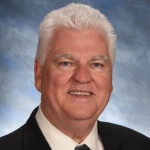 I’m Paul Whitley, and I am a Fractional CFO that helps businesses grow exponentially.
I’m Paul Whitley, and I am a Fractional CFO that helps businesses grow exponentially.
My goal is to help you achieve yours… … would you benefit from having a proven, principle-based fractional finance and operations team player?
I’m a Transformation Technology Leader with extensive experience in creative problem solving, operations management, coaching, mentoring and training. I’m a Servant Leader with a real passion for helping both large and small companies’ setup and implement financial, operational, and digital transformation initiatives that improve processes, reduce expense, and drive bottom-line profits….
